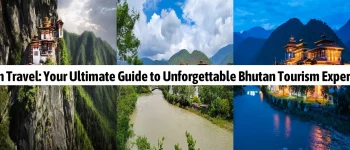Cambodia, a small but stunning country nestled between Vietnam, Laos, and Thailand, is a favorite stop on many South East Asia itineraries. While once popular mainly with backpackers, Cambodia now offers plenty for all types of travelers. With new luxury hotels, family-friendly activities, and improved transportation options, Cambodia has become a must-visit destination.
At the heart of Cambodia’s allure is Angkor Wat, a massive temple complex near Siem Reap. While Angkor Wat has long been the main draw for visitors, the country is now more accessible than ever. Improved roads and public transportation have made dozens of historically and culturally significant attractions easier to reach and explore. From the Killing Fields to the Royal Palace, Cambodia’s rich history and culture are well worth experiencing.
To help you plan your trip, we have enlisted the help of travel bloggers who have shared their insights and recommendations. From practical information to hidden gems, this Cambodia travel guide has everything you need to know before visiting this enchanting country.
History of Cambodia
Cambodia has a dark past that cannot be ignored. The country was ravaged by a brutal genocide in the late 1970s, under the rule of Pol Pot and the Khmer Rouge. Nearly 1.7 million Cambodians lost their lives over four years. The regime aimed to create an “equal” or “classless” society, resulting in the torture and killing of anyone with an education. Schools, factories, hospitals, and universities were shuttered, and teachers, doctors, engineers, and lawyers, as well as their families, were targeted.
No visit to Cambodia is complete without confronting this harrowing chapter in history. A visit to Phnom Penh should include a trip to the killing fields at Choeung Ek and the Tuol Sleng S-21 prison. Although challenging, these visits offer a necessary understanding of Cambodia’s painful past.
Useful Information
How to get to Cambodia?
The main airports in Cambodia are in Phnom Penh and Siem Reap. While there are no long-haul international flights directly to Cambodia, you can fly in from major destinations such as Hong Kong, Bangkok, and Singapore.
Efficient bus services are also available from major cities in neighboring countries, such as Ho Chi Minh City and Bangkok. Tickets can be purchased at travel agents’ stalls in Phnom Penh, Siem Reap, Ho Chi Minh City, or Bangkok.
Cambodia visas
Most nationalities need a visa to enter Cambodia, but you can easily obtain one on arrival at land borders and airports. The visa is valid for 30 days and can only be paid for in cash, so make sure to have $30 USD in crisp notes. Some land borders may also require passport photos, so it’s a good idea to have these on hand.
There is also the option to apply for an e-visa online before arriving. However, given the straightforward process of obtaining a visa on arrival, it is recommended to do so in person. Make sure to check your country’s official website for the most up-to-date entry and visa requirements due to the global coronavirus pandemic.
How to get around Cambodia?
Unlike Vietnam and Thailand, train travel is not well-established in Cambodia. Buses are the main mode of transportation, connecting travelers across the country. Although departure times are listed, buses often do not adhere to the schedules, so it’s important to allow extra time, particularly if you have a tight connection or need to catch a flight. Keep in mind that heavy rainfall during the rainy season can lead to further delays and impassable roads.
For shorter trips within towns, tuk-tuks are the easiest and relatively inexpensive way to get around. However, if you prefer the comfort and convenience of a private taxi, that option is also available.
When is the best time to go to Cambodia?
The rainy season in Cambodia lasts from May to around October, with July and August experiencing heavier rainfall. While visiting during this time can offer fewer crowds, it’s important to note that it can significantly impact outdoor activities. Planning for rain is essential if you choose to visit during this period.
The best time to visit Cambodia is from November to March, when the weather is mostly dry with long, sunny days. The humidity is also more manageable during this time. Keep in mind that better weather also means larger crowds and higher hotel prices, but the trade-off is worth it to avoid rainy days.
Currency
Cambodia uses two currencies – the US dollar and the Khmer riel. The US dollar was introduced in the 1990s to stabilize the economy and is widely accepted for tourist-related transactions. You can easily withdraw US dollars from ATMs or exchange money at local currency exchange stalls.
The Khmer riel is mainly used at market stalls, street vendors, and in informal settings. However, paying in US dollars is generally accepted, especially as tourists are more likely to have this currency on hand. It’s important to note that crumpled US dollar notes may be rejected by some places, so keep your currency in good condition. Crisp US dollars are also necessary at the Cambodia border and airport for entry.
Budget
Cambodia is a relatively budget-friendly destination, especially compared to other countries in South East Asia.
- Accommodation: Comfortable guesthouses start at around $30 USD per night, while nice hotel rooms can cost $60 USD or more. Backpacker hostels offer even cheaper options, with dorm rooms as low as $4 USD per night.
- Food: Street food vendors offer inexpensive meals, with prices ranging from $1-2 USD per meal. Simple meals at local restaurants typically cost $3-5 USD. Restaurants catering to tourists may be slightly more expensive, averaging around $5-15 USD per person.
- Transport: Tuk-tuks are the most budget-friendly mode of transportation within towns, while buses connect larger towns or areas. Bus fares from Phnom Penh to Siem Reap, for example, cost around $10 USD per person.
- Attractions: Most attractions in Cambodia are reasonably priced, with entry fees ranging from $5-10 USD. However, visiting iconic sites like Angkor Wat can be more expensive. Entry passes for Angkor Wat can be purchased for one day ($37 USD), three days ($62 USD), or seven days ($72 USD).
Cambodia: The Best Places to Visit
Phnom Penh
Phnom Penh, the capital of Cambodia, offers a fascinating mix of history and modernity. The city is rich in culture and features attractions such as the Royal Palace, the Tuol Sleng Genocide Museum, and the Choeung Ek Killing Fields. Exploring these sites provides a deep understanding of Cambodia’s past and the resilience of its people.
In addition to historical landmarks, Phnom Penh boasts vibrant markets, including the Russian Market and the Phnom Penh night market. The city is also known for its Happy Pizza parlors, where you can try a unique twist on traditional pizza.
When it comes to accommodation, Phnom Penh offers a wide range of options. From high-end hotels like the Rosewood Phnom Penh and Raffles Hotel Le Royal to mid-range options like Hotel Emion and the Pavilion Hotel, there is something to suit every budget. For a more affordable stay, hostels like Sla Boutique Hotel and Feliz Hostel provide comfortable accommodations.
Choeung Ek Killing Fields
Located just outside Phnom Penh, the Choeung Ek Killing Fields serve as a haunting reminder of Cambodia’s dark history under the Khmer Rouge regime. While visiting this site may be difficult, it offers an opportunity to pay homage to the victims and gain a deeper understanding of the country’s past. The Choeung Ek Killing Fields also feature a museum with informative exhibits and artifacts.
Siem Reap
Siem Reap is the ultimate destination for temple-hopping and immersing yourself in Khmer culture. Angkor Wat, the largest religious monument in the world, is the main highlight of Siem Reap and should not be missed. Watching the sunrise or sunset over the magnificent temple complex is a truly magical experience.
Apart from Angkor Wat, Siem Reap offers many other attractions, including the Cambodian Land Mine Museum, the floating village of Kompong Phluk, and traditional Apsara dance shows. Exploring the vibrant Pub Street and trying local delicacies at the Old Market are also must-dos.
In terms of accommodations, Siem Reap offers a variety of options. Luxury stays like the Park Hyatt Siem Reap and the Anantara Resort & Spa provide top-notch comfort, while mid-range options like Navutu Dreams Resort and Templation offer a balance between affordability and quality. Hostels like One Stop Hostel and Bokre Angkor Hostel cater to budget travelers.
Temple-hopping
In addition to Angkor Wat, Cambodia is home to a multitude of temples that showcase its rich history and architectural wonders.
- Ta Prohm: This temple, made famous by its appearance in the movie Tomb Raider, is a unique attraction with giant trees growing out of the ruins. The combination of ancient structures and natural overgrowth creates a mystical and eerie atmosphere.
- Bayon Temple at Angkor Thom: Known for its distinctive stone faces, Bayon Temple is one of the most important temples in the Angkor Thom complex. Exploring the intricate carvings and mysterious atmosphere is a must-do.
- Banteay Srei: Considered a gem of Khmer art, Banteay Srei is renowned for its intricate statues and reliefs. The temple’s smaller size allows visitors to appreciate the fine details and craftsmanship up close.
- Koh Ker: This ancient city boasts unique pyramid-shaped temples reminiscent of the Mayan pyramids. Climbing to the top for stunning views of the Cambodian jungles is a memorable experience.
- Sambor Prei Kuk: This off-the-beaten-track destination features a collection of temples from the Chenla Kingdom. With fewer tourists and beautiful carvings, Sambor Prei Kuk offers a peaceful and authentic experience.
Coastal, Riverside & Mountain Towns
Cambodia’s coastal towns, riverside cities, and mountain towns offer a different side of the country.
- Kep: A charming seaside village known for its pepper crab, Kep offers a relaxed atmosphere and beautiful beaches. Exploring the decaying French-style villas and hiking in Kep National Park are great activities to enjoy here.
- Kampot: Situated on the banks of the Preaek Tuek, Kampot offers a laid-back riverside experience. With its French colonial architecture, art galleries, and vibrant café and restaurant scene, Kampot is perfect for leisurely exploration.
- Bokor Mountain: Once a mountain luxury resort for French colonial residents, Bokor Mountain now offers stunning views, abandoned buildings such as the Black Palace, and the opportunity to learn about Cambodia’s past.
- Kratié: A town in eastern Cambodia, Kratié is known for its Irrawaddy dolphins, which can be observed during boat tours. Kratié also offers the chance to explore salt pans, pepper plantations, and local culture.
- Elephant Valley Project in Mondulkiri: For an ethical elephant encounter, the Elephant Valley Project in Mondulkiri offers an opportunity to observe elephants in their natural environment. Volunteers can also contribute to conservation efforts.
The Islands
Cambodia’s islands are an idyllic paradise, offering pristine beaches and crystal-clear waters.
- Koh Rong: The largest and most popular island, Koh Rong features 43km of white sandy beaches and a vibrant party atmosphere. Snorkeling, diving, and island hopping tours are popular activities here.
- Koh Rong Samloem: Koh Rong Samloem offers a more relaxed ambiance compared to its sister island, Koh Rong. With its pristine beaches, jungle treks, and the opportunity to witness bioluminescent plankton at night, Koh Rong Samloem is truly a slice of paradise.
Cambodia Travel Guide
Cambodia is a country of wonders, offering a diverse range of attractions and experiences. While Angkor Wat is undoubtedly a must-see, the country has so much more to offer. From historical landmarks and hidden temples to paradise islands and cultural gems, Cambodia is a destination that will captivate you.
Remember to plan your trip around the weather, bring cash for transactions, and consider the unique history and cultural significance of the sites you visit. Whether you’re exploring the bustling streets of Phnom Penh, wandering through the jungles of Siem Reap, or relaxing on the pristine beaches of the islands, Cambodia will leave you with memories that last a lifetime.
For more travel inspiration and detailed guides, explore the Ekilove website.
Disclaimer: This guide has no involvement from the local tourism board or a hotel.






